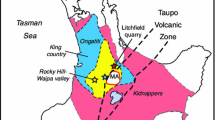Abstract
Ion microprobe (SHRIMP) dating was carried out on different zircon domains from metamorphic rocks of the HP-HT terrane of central Rhodope, northern Greece, to constrain the timing of prograde and retrograde stages within a single tectono-metamorphic cycle. A well determined P-T-t(relative) path for the metamorphic rocks of this terrane was used as a petrological basis for the geochronological investigations. Ion microprobe work was assisted by cathodoluminescence (CL) images of the zircon crystals. The geochronological results revealed that Hercynian continental crust was subducted during the Eocene. Several stages of the Eocene tectono-metamorphic cycle – including both the prograde and retrograde parts of the P-T path above ca 300 °C, 0.3 GPa – were dated using zircons from the following rock types: (1) A deformed quartz vein probably formed at ca 300 °C, 0.3 GPa. Zircons in this vein precipitated from a hydrothermal fluid; they yielded an age of 45.3 ± 0.9 Ma which corresponds to the time of a low-T prograde stage of metamorphism. (2) In kyanite eclogites, zircons were entirely reset during eclogite-facies metamorphism. Resetting was very probably enhanced by the presence of fluids derived by H2O liberating reactions close to the P-peak. They yielded an age of 42.2 ± 0.9 Ma. (3) Orthogneisses surrounding the kyanite eclogites contained zircons with magmatic oscillatory zoned cores, which yielded Hercynian ages of 294 ± 8 Ma (age of granitic protolith formation), whereas CL-bright, metamorphic rims yielded, like the eclogite zircons, ages of 42.0 ± 1.1 Ma. Therefore, both the eclogites and orthogneisses are interpreted to have approached maximum depth at around 42 Ma. (4) In a leucosome of a migmatized orthogneiss, oscillatory zoned zircons yielded an age of 40.0 ± 1.0 Ma. At this time the rocks reached maximum temperatures during early decompression. (5) A late pegmatite crosscutting the schistosity of amphibolites contained oscillatory zoned zircons that yielded a crystallization age of 36.1 ± 1.2 Ma. Thus, the whole tectono-metamorphic cycle above ca 300 °C, 0.3 GPa lasted from 45.3 ± 0.9 Ma to 36.1 ± 1.2 Ma, that is 9.2 Ma with an extreme error value of 2.1 Ma. Based on combined SHRIMP and petrological data, the average rates of heating and burial during subduction (above ca 300 °C, 0.3 GPa) are >94 °C/Ma and >15 mm/a, respectively. Rates of cooling and exhumation (also above 300 °C, 0.3 GPa) are calculated to be >128° C/Ma and >7.7 mm/a. The Eocene age of metamorphism in central Rhodope implies that the terrane of, at least, central Rhodope and the Cyclades very probably was part of the same continental crust.
Similar content being viewed by others
Author information
Authors and Affiliations
Additional information
Received: 5 October 1998 / Accepted: 18 January 1999
Rights and permissions
About this article
Cite this article
Liati, A., Gebauer, D. Constraining the prograde and retrograde P-T-t path of Eocene HP rocks by SHRIMP dating of different zircon domains: inferred rates of heating, burial, cooling and exhumation for central Rhodope, northern Greece. Contrib Mineral Petrol 135, 340–354 (1999). https://doi.org/10.1007/s004100050516
Published:
Issue Date:
DOI: https://doi.org/10.1007/s004100050516




